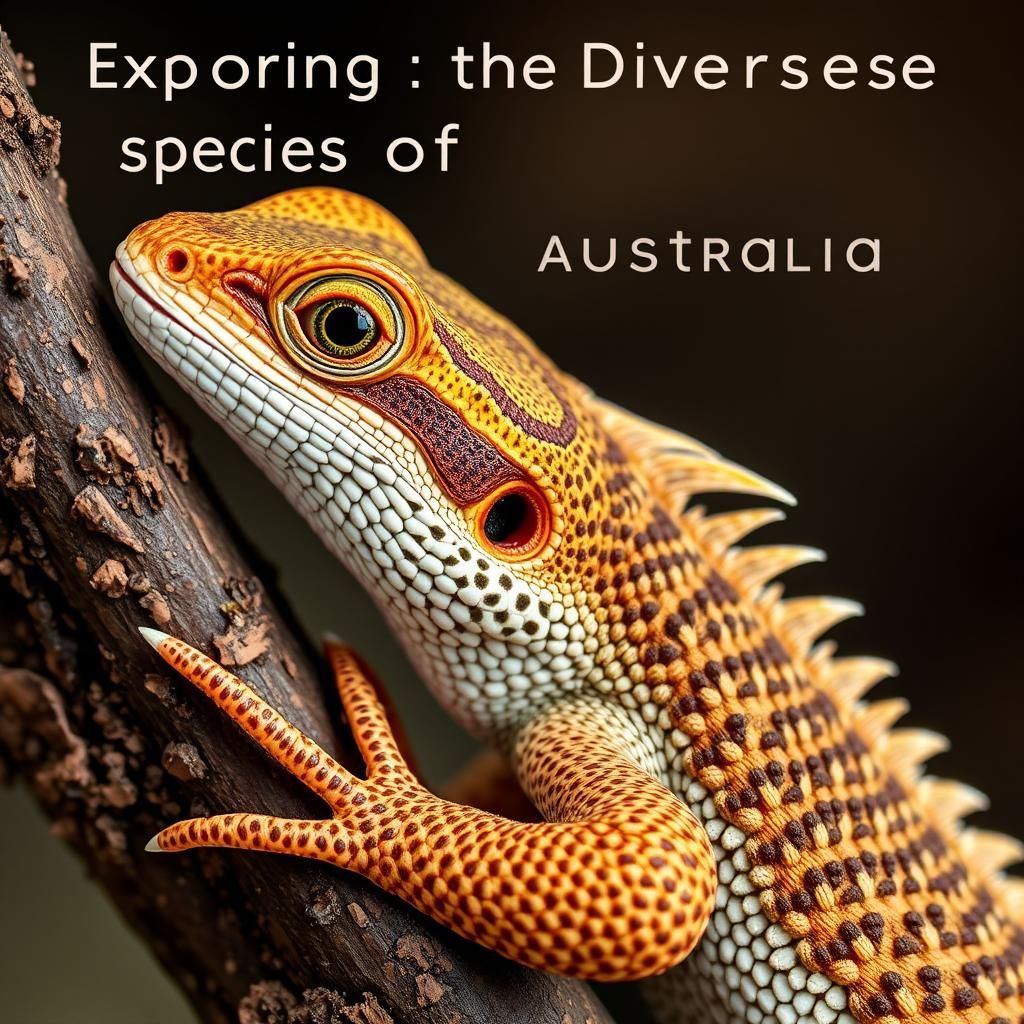Exploring the Diverse Species of Lizards in Australia: A Complete Guide

Australia is home to an astonishing diversity of lizard species, making it a prime destination for herpetologists and nature enthusiasts alike. With over 900 distinct types found across its varied landscapes, from arid deserts to lush rainforests, these reptiles exhibit an incredible range of colors, sizes, and behaviors. This complete guide aims to delve into the fascinating world of Australian lizards, exploring their unique adaptations, habitats, and roles in the ecosystem. Whether you're a seasoned researcher or a casual observer, understanding these creatures offers valuable insights into the rich biodiversity of Australia and the importance of conservation efforts.
Species of Lizards in Australia
Australia is home to a diverse array of lizard species, making it one of the richest regions for lizard biodiversity in the world. Among the captivating species are the iconic goannas, the colorful blue-tongued skinks, and the intriguing thorny devil. These reptiles occupy a variety of habitats, from arid deserts to lush rainforests, showcasing remarkable adaptations that help them thrive in Australia's often harsh environmental conditions. The study of these lizards not only reveals insights into their ecology but also highlights the role they play in their respective ecosystems as both predators and prey.
1. Blue-Tongued Skink
The blue-tongued skink is easily recognizable due to its distinctive blue tongue, which it displays as a defense mechanism against predators. This lizard inhabits a range of environments, from forests to grasslands, primarily found along the southeastern coast of Australia. Blue-tongued skinks are omnivorous, feeding on insects, vegetables, and fruits. They are known for their docile nature, making them popular as pets and an excellent subject for herpetological studies.
2. Thorny Devil
The thorny devil, known scientifically as Moloch horridus, is a unique lizard that resides in arid regions of Australia. With its stunning spiny appearance and ability to change color slightly based on its environment, it is well-adapted to desert life. This lizard primarily feeds on ants, utilizing its specialized tongue to capture its prey. Interestingly, it has a remarkable ability to absorb moisture through its skin, enabling it to survive in environments with limited water sources.
3. Goanna
Goannas are a large group of monitor lizards belonging to the genus Varanus. These lizards are found throughout Australia and vary greatly in size and color. Goannas are carnivorous, preying on small mammals, birds, and even other reptiles. Their keen sense of smell, aided by their forked tongues, allows them to locate food efficiently. Some species are also known for their remarkable climbing abilities, which they use to escape predators or pursue prey.
4. Frill-necked Lizard
The frill-necked lizard, or Chlamydosaurus kingii, is renowned for the large fold of skin around its neck that it can flare out when threatened. This dramatic display serves as a defense mechanism, making the lizard appear larger and more intimidating to predators. Native to the tropical woodlands of northern Australia, these lizards primarily feed on insects and use their agility to navigate through trees and shrubs. Their fascinating mating rituals and stunning appearance make them a favorite subject among wildlife enthusiasts.
5. Lace Monitor
The lace monitor, also known as the lace goanna or Varanus varius, is one of the largest monitor lizards in Australia, reaching lengths of up to 2.5 meters. This species is notorious for its intelligence and adaptability, often seen in various habitats, from forests to coastal environments. Lace monitors are opportunistic feeders, consuming a diverse diet that includes eggs, small mammals, and carrion. Their impressive climbing skills and keen sense of smell make them adept hunters, and they play a crucial role in controlling the populations of their prey.
| Species | Habitat | Diet |
|---|---|---|
| Blue-Tongued Skink | Forests, grasslands | Omnivorous |
| Thorny Devil | Arid regions | Ants |
| Goanna | Varied, including coastal areas | Carnivorous |
| Frill-Necked Lizard | Tropical woodlands | Insects |
| Lace Monitor | Forests, coastal environments | Varied, including small mammals |
What is the most common lizard in Australia?

The most common lizard in Australia is the blue-tongue skink (Tiliqua scincoides). This lizard is widely recognized for its distinctive blue tongue, which it displays as a defense mechanism against predators. Blue-tongue skinks are adaptable creatures that thrive in a variety of habitats, including forests, grasslands, and suburban areas. Their diet is omnivorous, feeding on insects, fruits, and vegetation, which makes them highly versatile in terms of survival.
Physical Characteristics
Blue-tongue skinks are characterized by their robust bodies and relatively short limbs. They can reach lengths of up to 28 inches (70 cm). The most notable feature is their vivid blue tongue, which can be displayed as a warning to potential threats. Additionally, their coloration is usually a mix of browns, yellows, and blacks, providing excellent camouflage in their natural environments.
- Robust body structure
- Length of up to 28 inches (70 cm)
- Camouflaging coloration
Habitat and Distribution
The blue-tongue skink is found throughout eastern and southern Australia, thriving in a range of habitats. They commonly inhabit woodlands, scrublands, and urban areas. Their ability to adapt to human settlements makes them one of the most frequently spotted lizards in suburban backyards. This adaptability has contributed to their population stability despite habitat changes.
- Woodlands
- Scrublands
- Urban environments
Diet and Feeding Habits
Blue-tongue skinks are omnivores, allowing them to consume a wide variety of food sources. Their diet typically includes fruits, vegetables, and insects. This diverse diet not only helps in their growth and health but also enables them to adapt to seasonal variations in food availability.
- Fruits such as berries
- Vegetables like leafy greens
- Insects including crickets and mealworms
Behavior and Defense Mechanisms
Blue-tongue skinks exhibit a range of interesting behaviors, particularly when threatened. Their primary defense mechanism is to display their bright blue tongues, which can startle predators. Additionally, they may hiss loudly and puff up their bodies to appear larger. If threatened further, they often retreat by burrowing into the ground or hiding in nearby foliage.
- Displaying their blue tongue
- Hissing as a warning
- Burrowing for safety
Reproduction and Lifespan
Blue-tongue skinks typically reach sexual maturity at around two years of age. They are ovoviviparous, meaning they give birth to live young rather than laying eggs. A single litter can consist of up to 25 offspring. In captivity, blue-tongue skinks can live for over 15 years, while in the wild, their lifespan may be shorter due to various environmental factors.
See also:
- Sexual maturity at two years
- Live births of up to 25 young
- Potential lifespan of over 15 years in captivity
What is Australia's biggest lizard?

The biggest lizard in Australia is the Perentie (Varanus giganteus). This impressive creature is a member of the monitor lizard family and can reach lengths of up to 2.5 meters (about 8.2 feet). Perenties are primarily found in the arid regions of Australia and are known for their remarkable adaptability, hunting skills, and diverse diet which makes them efficient predators.
Physical Characteristics
The Perentie has distinctive characteristics that set it apart from other lizards.
- Size: They can grow up to 2.5 meters, making them the largest lizard in Australia.
- Coloration: Typically featuring a pattern of yellow or white spots on a darker background, their coloration provides effective camouflage in their desert habitat.
- Tongue: Like many monitors, they have a long, forked tongue that helps them sense their environment, detecting chemicals in the air.
Habitat and Distribution
The Perentie inhabits a variety of environments, particularly thriving in semi-arid to arid regions.
- Geographical Range: They are predominantly found in the northern, central, and western parts of Australia.
- Preferred Environments: Perenties can be seen in woodlands, savannas, and rocky areas, which they use for shelter and hunting.
- Climate Adaptability: They are well adapted to the harsh conditions of the Australian outback, able to withstand high temperatures.
Diet and Hunting Behavior
As carnivorous lizards, Perenties have a varied diet that contributes to their role as apex predators.
- Primary Food Sources: They primarily feed on small mammals, birds, and even other reptiles.
- Hunting Techniques: Utilising keen eyesight and speed, they chase down prey, often ambushing them.
- Scavenging: Perenties are also known to scavenge and will consume carrion if the opportunity arises.
The Perentie exhibits unique behavioral traits that are important for its survival in the wild.
- Solitary Nature: Generally, they are solitary creatures, coming together only during mating season.
- Territorial Behavior: They can be territorial, especially males, who may engage in displays of dominance.
- Burrowing: They often dig burrows or utilize existing ones for nesting and shelter from extreme heat.
Conservation Status
While the Perentie is not currently considered endangered, there are factors that could affect its future.
- Threats: Habitat destruction and road mortality pose significant threats to their populations.
- Protection Efforts: They are protected under Australian law, and efforts are made to conserve their habitats.
- Awareness: Increasing public awareness about their ecological role helps promote their protection.
What is the famous Australian lizard?

The famous Australian lizard is the Perentie (Varanus giganteus), which is known for being one of the largest lizards in Australia. The Perentie can grow up to 2.5 meters (8.2 feet) in length and is a carnivorous monitor lizard. They are primarily found in the arid regions of Australia, including deserts and rocky areas, where they hunt for prey and adapt to their environment.
Characteristics of the Perentie
The Perentie possesses distinct physical traits that enable it to thrive in harsh conditions. Some of the key characteristics include:
- Size: The Perentie is the largest terrestrial lizard in Australia, capable of reaching an impressive length of up to 2.5 meters.
- Coloration: Its scales typically exhibit a combination of brown and yellow markings, providing effective camouflage in its natural habitat.
- Limbs: It possesses strong limbs equipped with sharp claws for climbing and digging.
Habitat and Distribution
The Perentie is predominantly found in Australia’s arid and semi-arid regions. Understanding where these lizards live helps to appreciate their unique adaptations. They typically inhabit:
- Deserts: The vast deserts of central Australia serve as their primary habitat, where they can find plenty of prey.
- Rocky areas: They favor areas with rocky outcrops which provide shelter and places to hunt.
- Sandy plains: These terrains are also part of their distribution, providing open spaces for sunbathing and hunting.
Diet and Hunting Behavior
The Perentie is a carnivorous lizard with a diverse diet. Its hunting techniques are fascinating and include:
- Ambush hunting: They often use stealth and camouflage to approach their prey.
- Efficient diggers: With strong limbs, they can dig into burrows to flush out prey like rodents and other small animals.
- Scavenging: Occasionally, Perenties will scavenge on carcasses, showcasing their adaptability.
Reproduction and Lifespan
Perentie lizards have a unique reproductive cycle and life strategies that ensure the survival of their species. Important aspects include:
- Egg-laying: Female Perenties lay between 10 to 20 eggs in burrows, providing safety and warmth for the developing young.
- Incubation period: The eggs typically incubate for around 3 to 4 months before hatching.
- Lifespan: In the wild, Perenties can live up to 20 years, although predation and environmental factors can impact their lifespan.
Conservation Status
The Perentie is currently not listed as endangered, but various factors can threaten their population. Key conservation points include:
See also:
- Habitat loss: Urban development and land use changes can reduce their natural habitats.
- Invasive species: Predation by introduced species such as cats and foxes can significantly impact Perentie populations.
- Conservation efforts: Awareness and protection of their habitats are crucial for maintaining stable populations.
What are the 5 families of lizards in Australia?

The five families of lizards found in Australia are:
1. Agamidae: This family includes the commonly known dragons and agamids. Agamids are characterized by their robust bodies and often vibrant colors. They are prevalent across various habitats, from deserts to forests.
2. Scincidae: Commonly referred to as skinks, this family is the most diverse in Australia. Skinks are often identified by their smooth, shiny scales and elongated bodies. They are highly adaptable and can occupy a wide range of ecological niches.
3. Varanidae: This family encompasses the monitor lizards, including the well-known goanna species in Australia. Monitors are recognized for their distinctive body shapes, long tails, and sharp claws, making them efficient predators in their environments.
4. Pygopodidae: Known as flap-footed lizards, this family is unique due to the absence of limbs in many species. Instead, these lizards have adapted to a burrowing lifestyle, using their elongated bodies to navigate through the soil.
5. Teiidae: This family comprises the whiptails and has relatively few representatives in Australia. Teiids are recognized for their agility and speed, often found in open areas where they can quickly escape predators.
1. Agamidae: Characteristics and Distribution
The Agamidae family showcases a diverse group of lizards, prominent for their climbing abilities and territorial behaviors. Many agamids can be spotted basking on rocks or tree branches, displaying their vibrant colors to attract mates.
- Body shapes can vary widely; some are flattened for better camouflage.
- They can exhibit social behaviors, especially during mating seasons.
- Common species include the Eastern Water Dragon and the Frilled-neck Lizard.
2. Scincidae: Adaptability and Behavior
The Scincidae family is fascinating due to its immense diversity. Skinks thrive in various environments, showcasing adaptability that allows them to survive in urban areas as well as natural habitats.
- Many skinks have a shiny appearance due to their smooth scales.
- Some species exhibit a form of parthenogenesis, a reproductive strategy where females can reproduce without males.
- Common examples include the Five-lined Skink and the Common Garden Skink.
3. Varanidae: The Monitor Lizards
The Varanidae family is known for its size and predatory nature. Monitor lizards, such as the Komodo dragon, hold a significant role in the food chain within Australian ecosystems.
- Monitor lizards exhibit strong swimming abilities, enabling them to hunt in water.
- Their keen sense of smell aids them in locating prey from considerable distances.
- Species like the Perentie and the Lace Monitor are notable Australians members.
4. Pygopodidae: Unique Adaptations
The Pygopodidae family represents a unique evolutionary path among Australian lizards. Often mistaken for snakes, these legless lizards rely on their fleshy appendages for mobility.
- They are often found in sandy or loose soil, where their burrowing habits excel.
- Their skin is commonly smooth and shiny, aiding in their subterranean lifestyle.
- Examples include species like the Common Brown Skink and the Southern Fling-footed Lizard.
5. Teiidae: Speed and Agility
The Teiidae family, though less represented in Australia, includes some uniquely adapted lizards known for their remarkable speed. These lizards are often seen darting across open grounds in search of food or evading threats.
- Their elongated body shape aids in rapid movement across terrains.
- Some species are known for their impressive displays during mating rituals.
- Australian members are less common, making their study important for understanding biodiversity.
Questions from Our Readers
What are some common species of lizards found in Australia?
Australia is home to a wide variety of lizard species, including the blue-tongue skink, thorny devil, and frilled-neck lizard. Each species has unique adaptations that help them thrive in their specific habitats across the continent.
Are Australian lizards venomous?
While most Australian lizards are non-venomous, a few exceptions exist, such as the ryan's brown tree snake which is closely related to some lizards. However, their bites are generally not harmful to humans, and they pose little threat.
See also:
What do Australian lizards eat?
Australian lizards have diverse diets that can include insects, small mammals, and plants, depending on the species. For example, the goanna is known to be a carnivorous lizard, while others, like the blue-tongue skink, enjoy a more omnivorous diet.
How do Australian lizards adapt to their environment?
Australian lizards display various adaptations for survival, such as camouflage, which helps them evade predators, and behavioral adaptations like basking in the sun to regulate their body temperature. These traits are crucial for their survival in diverse and often harsh Australian climates.

If you want to read more articles like Exploring the Diverse Species of Lizards in Australia: A Complete Guide, we recommend you check out our Ninguna de las categorías propuestas es adecuada para el artículo mencionado. category.
Leave a Reply
Related Articles